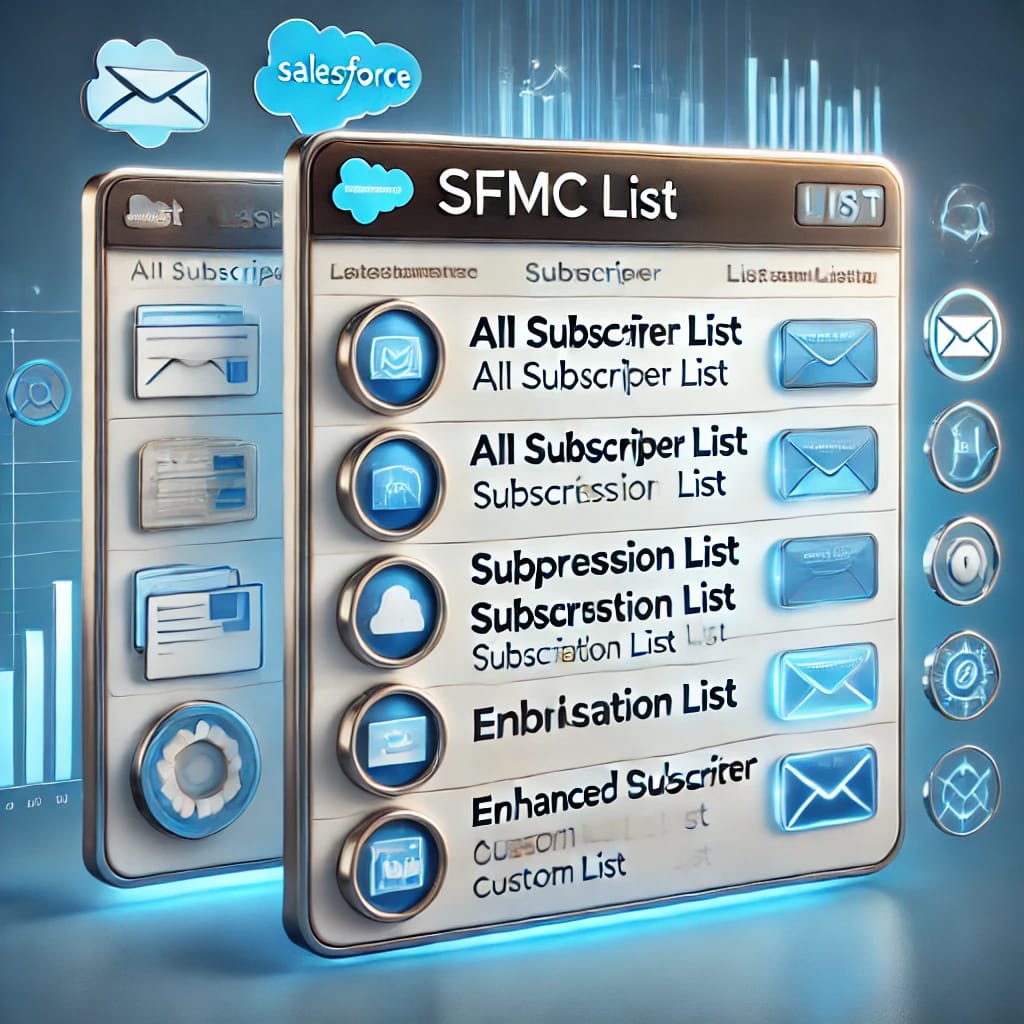Salesforce Marketing Cloud (SFMC) offers powerful tools to help marketers manage subscriber data effectively. Among these tools, Lists are a central method for storing and organizing data within Email Studio. This guide will walk you through the various types of lists in SFMC, including Publication Lists, and how to create and manage them. It will also highlight best practices for using lists for targeted marketing campaigns and segmentation.
What are Lists in Salesforce Marketing Cloud?
In Salesforce Marketing Cloud (SFMC), Lists are the default method for storing subscriber data in Email Studio. They allow you to manage and segment subscribers based on simple attributes like email address, first name, and subscription preferences. Lists are best suited for managing small to mid-sized campaigns, particularly when your subscriber base is below 500,000. They are ideal for simpler subscriber models that don’t require complex commercial or transactional data.
A list is a group of subscribers who receive your communications. You can create multiple lists to segment your audience and tailor your email campaigns accordingly.
Key Features of Lists:
- Subscriber Data: Lists store basic subscriber information such as email address (required), first name, last name, age, gender, and more.
- Profile Attributes: Lists allow you to manage subscriber profile data such as preferences, subscriber status, and other personal attributes.
- Limitations: Lists in SFMC have a limit of 200 user profile attributes. If you need to store more attributes, you’ll need to use Data Extensions.
What are the types of List in Salesforce Marketing Cloud?
SFMC offers various list types to help you manage subscribers more efficiently. Below are the common types:
All Subscribers List
The All Subscribers List is a system-generated list that includes all email addresses in your SFMC account, regardless of subscription status. It serves as a master list and is often used for system-generated emails or fallback options when a subscriber is not present in any other list.
The All-Subscribers List contains all email addresses in your SFMC account, regardless of their subscription status.
Suppression List
A Suppression List is used to exclude specific subscribers from receiving particular communications. This is helpful for managing people who have unsubscribed or have opted out of specific types of communication.
Publication List
A Publication List helps you manage subscriber preferences by category. It allows subscribers to opt in or out of specific types of emails, such as newsletters, promotions, or product updates. This segmentation ensures that you only send relevant emails to those who want to receive them.
Benefits of Publication Lists:
- Improved Subscriber Experience: Allows subscribers to manage their preferences and reduce email fatigue.
- Enhanced Targeting: Tailor campaigns based on subscriber preferences.
- Regulatory Compliance: Helps meet legal requirements, such as CAN-SPAM laws.
Enhanced Subscriber Lists
These lists allow you to create dynamic or static lists based on specific filtering or segmentation criteria. For example, you could create an Enhanced Subscriber List to include all subscribers who made a purchase within the last 30 days.
Custom Lists
Custom lists are designed to address specific business requirements or to organize subscribers based on unique attributes or criteria. These lists are typically used for more targeted marketing efforts.
Example: A custom list could be created to target frequent buyers who regularly purchase specific product categories. This list can be used for personalized email campaigns featuring exclusive offers or product recommendations based on their purchasing behavior.
What are the best practices for using lists in Salesforce Marketing Cloud?
- Segment Subscribers: Organize your lists based on subscriber preferences, behaviors, and demographics. This helps improve the relevance of your campaigns and engagement rates.
- Use Publication Lists: Create publication lists for each communication category (e.g., newsletters, promotions, alerts) to ensure your subscribers receive only the content they’re interested in.
- Regularly Clean Your Lists: Remove inactive or bounced email addresses from your lists to maintain a healthy sender reputation and avoid deliverability issues.
- Follow Compliance Guidelines: Ensure your publication lists are set up to adhere to legal requirements like CAN-SPAM, GDPR, and other regional data protection laws.
So, Lists in Salesforce Marketing Cloud are crucial for managing your subscriber data and creating effective, targeted marketing campaigns. Whether you are using standard lists for basic subscriber management or publication lists for advanced communication preference management, understanding how to set them up and use them efficiently will enhance your email marketing efforts. By allowing subscribers to control their email preferences, you improve the customer experience, increase engagement, and reduce unsubscribe rates. Keep your lists organized, regularly update your data, and leverage the power of publication lists to drive more personalized and compliant marketing campaigns.
You can read more about list from –

Leave a Reply